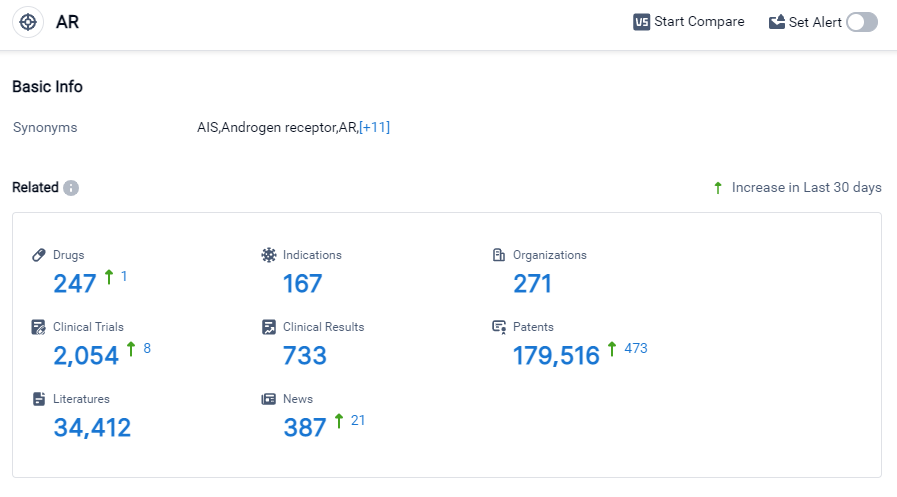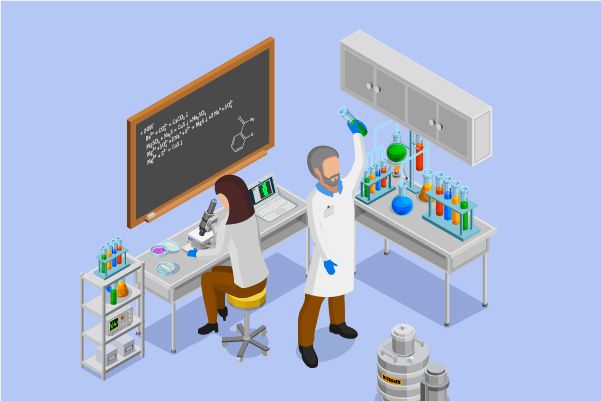Analysis on the Clinical Research Progress of Androgen Receptor Inhibitor
Androgen receptor (AR) is a type of nuclear receptor that is activated by binding of either of the androgenic hormones testosterone or dihydrotestosterone in the cytoplasm and then translocating into the nucleus. Upon binding the hormone ligand, the receptor dissociates from accessory proteins, translocates into the nucleus, dimerizes, and then stimulates transcription of androgen responsive genes. The androgen receptor is most closely related to the progesterone receptor, and progestins in higher dosages can block the androgen receptor. The main function of the androgen receptor is as a DNA-binding transcription factor that regulates gene expression. Androgen regulated genes are critical for the development and maintenance of the male sexual phenotype. Mutations in this gene are also associated with complete androgen insensitivity (CAIS).
The primary form of androgens is testosterone, which plays a crucial role in the body. Besides being involved in reproduction, it also maintains hormonal balance in the body; stimulates protein synthesis metabolism, promotes nitrogen deposition, and increases the number of muscle fibers and their thickness.
Androgen receptor (AR) is a ligand-dependent transcription factor that can regulate the expression of specific downstream genes. It belongs to the nuclear receptor superfamily of steroid hormone receptors, along with estrogen receptor (ER), glucocorticoid receptor (GR), progesterone receptor (PR), and mineralocorticoid receptor (MR). The AR gene is located at Xq11-Xq12 on the X-chromosome, the protein-coding region contains 2757 nucleotides, which include 8 exons and 7 introns, with the intron size ranging from 0.7 to 2.6kb. The protein encoded by the AR gene is composed of 919 amino acids, with a molecular weight of about 110kDa. AR is composed of four main functional domains: (1) N-terminal domain (NTD); (2) DNA binding domain (DBD); (3) C-terminal ligand binding domain (LBD); (4) flexible hinge region. These four structural domains are essential for the biological function of AR.
Additionally, AR is involved in various physiological processes, including bone and muscle growth, hair growth, and the regulation of mood and cognition. Dysregulation of AR activity can contribute to several diseases, including prostate cancer and androgen insensitivity syndrome. Understanding the role of AR is essential for developing targeted therapies and improving patient outcomes in the pharmaceutical industry.
Due to point mutations in the ligand-binding domain of the androgen receptor, the expression of splice variants, and various other factors, current treatments for prostate cancer have consequently become ineffective. Therefore, there is an urgent need for new strategies to treat prostate cancer. In recent years, the targeted protein degradation technology has made significant progress. In particular, androgen receptor degraders obstruct the androgen receptor signaling pathway by promoting the degradation of androgen receptors, potentially solving the problem of drug resistance in clinical prostate cancer patients. Compared to the inherent druggability deficiencies of PROTAC molecules, these small-molecule androgen receptor degraders have greater advantages and are becoming the main focus of research into prostate cancer treatment.
Androgen Receptor Competitive Landscape
According to Patsnap Synapse, as of 27 Sep 2023, there are a total of 247 AR drugs worldwide, from 271 organizations, covering 167 indications, and conducting 2054 clinical trials.
👇Please click on the picture link below for free registration or login directly if you have freemium accounts, you can browse the latest research progress on drugs , indications, organizations, clinical trials, clinical results, and drug patents related to this target.
The current competitive landscape in the target AR is characterized by the active involvement of several pharmaceutical companies, including Bayer AG, Pfizer Inc., and Suzhou Kintor Pharmaceuticals, Inc. These companies have a significant number of drugs in various stages of development, indicating their commitment to research and development in this area. The most common indications for the approved drugs include prostatic cancer, hypogonadism, breast cancer, osteoporosis, hot flashes, endometriosis, etc. Small molecule drugs and PROTACs are the drug types that are progressing most rapidly, indicating the focus on innovative approaches in drug development. The United States, China, and the European Union are the countries/locations that are developing fastest, with significant contributions to the research and development efforts in the target AR. Overall, the target AR presents a competitive landscape with diverse drug types, indications, and geographical locations, indicating a promising future for the development of treatments in this area.





